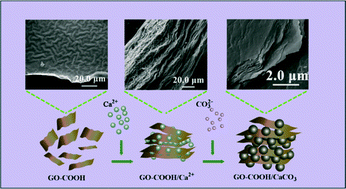A bio-inspired nacre-like layered hybrid structure of calcium carbonate under the control of carboxyl graphene†
Abstract
In this paper, carboxyl graphene (GO-COOH) sheet matrices, which are heavily oxygenated and are similar to the organic matrices of molluscs, were used to construct nacre-like layered structures. The results showed that the surface of the hybrids was smooth and the cross section had a multilayer structure. Both the surface and the interlayer of the composite material generated calcium carbonate (CaCO3) crystals. Furthermore, the spontaneity of the layered structure was found to be closely related to the concentration of the CaCO3 crystals in which high concentration could inhibit the process, highlighting the determining role of the CaCO3 concentration. To better understand the mechanisms for the formation of the layered structure, scanning electron microscopy (SEM), transmission electron microscopy (TEM), X-ray diffraction (XRD), thermogravimetric analysis (TGA) and Fourier transform infrared spectrometry (FT-IR) were employed. This work presents an efficient and controllable way to construct nacre-like layered hybrid structures and also has great potential for promoting the application of GO-COOH in biomedical engineering, especially in the field of biomimetic materials.


 Please wait while we load your content...
Please wait while we load your content...